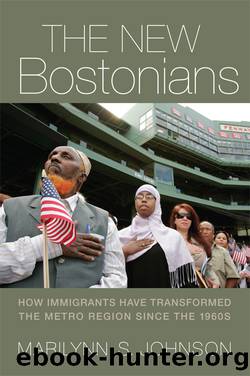The New Bostonians by Marilynn S. Johnson

Author:Marilynn S. Johnson [Johnson, Marilynn S.]
Language: eng
Format: epub
Tags: SOC007000 Social Science / Emigration & Immigration
Publisher: University of Massachusetts Press
FIGURE 15. Father Fred OâBrien, the first director of the Hispanic apostolate in the Boston archdiocese, leads a class with Puerto Rican migrant workers at a farm in Concord in 1957. Photo courtesy of Boston Globe.
Outreach to Spanish-speaking migrants in the Boston Archdiocese first began in the 1950s, with the arrival of Puerto Rican agricultural workers in outlying communities. The church assigned Spanish-speaking priests to minister to these workers and set up community centers at local churches (fig. 15). As Puerto Ricans and Cubans settled in Bostonâs South End, the Cathedral of the Holy Cross began offering a Spanish-language Mass, and in 1957 Cardinal Richard Cushing established the Hispanic apostolate to coordinate Spanish-language Masses and pastoral services. That same year the archdiocese also founded El Centro del Cardenal in the South End as a social service center for the cityâs Latinos. Soon Spanish-speaking seminary students were working with Puerto Ricans at local parishes and staffing a travelersâ aid service at Logan Airport.4
Outside of the South End, though, the churchâs response to new Latino arrivals was uneven at best. The first director of the Hispanic apostolate, Father Fred OâBrien, explained in a 1998 interview that the reception of Latinos depended mainly on the initiatives of local priests: âThey left us on our own. Each city had a different experience. Priests working with Latinos were very creative. The Cardinal didnât have a policy. . . . In this country, the hierarchy doesnât know what to make of [Latinos] even now.â His successor in the 1970s, Father Daniel Sheehan, added that financial pressures on aging urban parishes also limited institutional support, and that âfew in the Archdiocese were willing to promote Latinos and to be prepared for the future.â Nevertheless, local parishes responded piecemeal to the growing Latino population by adding Spanish Masses and clergy. In the 1980s, many became pan-Latino as new waves of Central Americans and Colombians arrived in the region. In 1988 the archdiocese appointed an auxiliary bishop, Roberto Octavio González, a Franciscan born in Puerto Rico, to represent the estimated 150,000 Hispanic Catholics in the region. By 2000, the Hispanic apostolate coordinated Spanish Masses and programs at thirty-six parishes in greater Boston.5
During these years, the Catholic Church extended a welcome to other migrants as well, including Haitians, Vietnamese, and Brazilians. Beginning in the 1960s, Haitian immigrants clustered around St. Leoâs and St. Matthewâs churches in South Dorchester and later expanded into St. Angelaâs in Mattapan and Our Lady of Pity in Cambridge. Vietnamese refugees built a large congregation at St. Peterâs in Fields Corner, while the Allston-Brighton Vietnamese community attended St. Aidanâs in nearby Brookline. These and other immigrant congregations were placed under the supervision of the Office of Ethnic Apostolates, established by the archdiocese in the late 1980s.6
Over the next decade, the Office of Ethnic Apostolates would coordinate new ministries for Brazilians, Africans, and other groups as well. As Portuguese speakers, Brazilian newcomers sometimes found a home with existing Portuguese churches, but different worship styles and tensions rooted in past colonial relationships made some Portuguese parishes unwilling to host the newcomers.
Download
This site does not store any files on its server. We only index and link to content provided by other sites. Please contact the content providers to delete copyright contents if any and email us, we'll remove relevant links or contents immediately.
4 3 2 1: A Novel by Paul Auster(12233)
The handmaid's tale by Margaret Atwood(7644)
Giovanni's Room by James Baldwin(7123)
Asking the Right Questions: A Guide to Critical Thinking by M. Neil Browne & Stuart M. Keeley(5582)
Big Magic: Creative Living Beyond Fear by Elizabeth Gilbert(5562)
Ego Is the Enemy by Ryan Holiday(5235)
The Body: A Guide for Occupants by Bill Bryson(4893)
On Writing A Memoir of the Craft by Stephen King(4830)
Ken Follett - World without end by Ken Follett(4602)
Adulting by Kelly Williams Brown(4444)
Bluets by Maggie Nelson(4437)
Eat That Frog! by Brian Tracy(4392)
Guilty Pleasures by Laurell K Hamilton(4285)
The Poetry of Pablo Neruda by Pablo Neruda(3997)
Alive: The Story of the Andes Survivors by Piers Paul Read(3929)
White Noise - A Novel by Don DeLillo(3920)
Fingerprints of the Gods by Graham Hancock(3906)
The Book of Joy by Dalai Lama(3862)
The Bookshop by Penelope Fitzgerald(3728)
